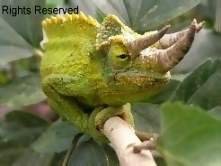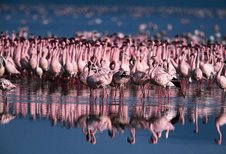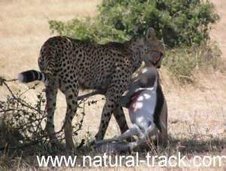The scientific name "Lycaon pictus" which is derived from the Greek for "wolf" and the Latin for "painted".The African Wild Dog is a medium sized canid found only in Africa.
It is the only species in the genus Lycaon.
It is also called the Painted Hunting Dog, African Hunting Dog, the Cape Hunting Dog, the Spotted Dog, or the Painted Wolf in English, and Mbwa mwitu in Swahili. Adults typically weigh 17-36 kilograms (37-79 pounds). It stands about 30 inches (75 cm) at the shoulder, with a head and body length averaging about 40 inches (100 cm) and a tail of 12 to 18 inches (30–45 cm).
There is little sexual dimorphism, though judging by skeletal dimensions, males are usually 3-7% larger.it has 42 teeth in total. The premolars are relatively large compared with those of other canids, allowing it to consume a large quantity of bone, much like hyenas.The heel of the lower carnassial M1 is crested with a single cusp, which enhances the shearing capacity of teeth and thus the speed at which prey can be consumed.
This feature is called trenchant heel and is shared with two other canids: the Asian Dhole and the South American Bush Dog. The African Wild Dog reproduces at any time of year, although mating peaks between March and June during the second half of the rainy season. Litters can contain 2-19 pups, though 10 is the most usual number.
The time between births is usually 12–14 months. Pups are usually born in an abandoned den dug by other animals such as those of the Aardvark. Weaning takes place at about 10 weeks. After 3 months, the den is abandoned and the pups begin to run with the pack. At the age of 8–11 months they can kill small prey, but they are not proficient until about 12–14 months, at which time they can fend for themselves.
Pups reach sexual maturity at the age of 12–18 months. In packs, there are separate male and female hierarchies that will split up if either of the alphas die. In the female group, the oldest will have alpha status over the others, so a mother will retain her alpha status over her daughters. For the males, in contrast the youngest male or the father of the other males will be dominant.
Dominance is established without blood-shed, as most dogs within a group tend to be related to one another in some way, and even when not this can occur. They have a submission-based hierarchy, instead of a dominance based one. Unrelated African Wild Dogs sometimes join up in packs, but this is usually temporary. Occasionally, instead unrelated cape dogs will attempt hostile takeovers of packs.
The African Wild Dog hunts in packs. Like most members of the dog family, it is a cursorial hunter, meaning that it pursues its prey in a long, open chase. The dogs have a peculiar rather playful ceremony that bonds them for a common purpose and initiates each hunt. They start circulating among the other pack members, vocalizing and touching until they get excited and are ready to hunt.
Its voice is characterized by an unusual chirping or squeaking sound, similar to a bird. After a successful hunt, hunters regurgitate meat for those that remained at the den during the hunt, such as the dominant female and the pups. They will also feed other pack members, such as the sick, injured, the very old that cannot keep up, or those who stayed back to watch the pups.
The African Wild Dog's main prey varies among populations but always centers around medium-sized ungulates, such as the impala, Thomson's Gazelle, and wildebeest. While the vast majority of its diet is made up of mammal prey, it sometimes hunts large birds, especially Ostriches. Hunting larger prey requires a closely coordinated attack, beginning with a rapid charge to stampede the herd.
One African Wild Dog then grabs the victim's tail, while another attacks the upper lip, and the remainder disembowel the animal while it is immobilised. This behaviour is also used on other large dangerous prey, such as the African Buffalo, giraffe calves, and large antelope even the one-ton Giant Eland.
The dogs often eat their prey while it is still alive. Remarkably, this large-animal hunting tactic appears to be a learned behavior, passed on from generation to generation withinthe species. The home range of packs varies enormously, depending on the size of the pack and the nature of the terrain.
Their preferred habitat is deciduous forests because of large prey herd size, lack of competition from other carnivores, and better sites for denning. No two wild dogs are marked exactly the same, making it easy to identify different individuals. Why such a pattern should develop, and how it serves the hunting dog, has long intrigued scientists.
These long-legged canines have only four toes per foot, unlike other dogs, which have five toes on their forefeet. African hunting dogs are endangered. They are faced with shrinking room to roam in their African home. They are also quite susceptible to diseases spread by domestic animals.
PKP-Kenya safari desk
Natural Track Safaris









No comments:
Post a Comment